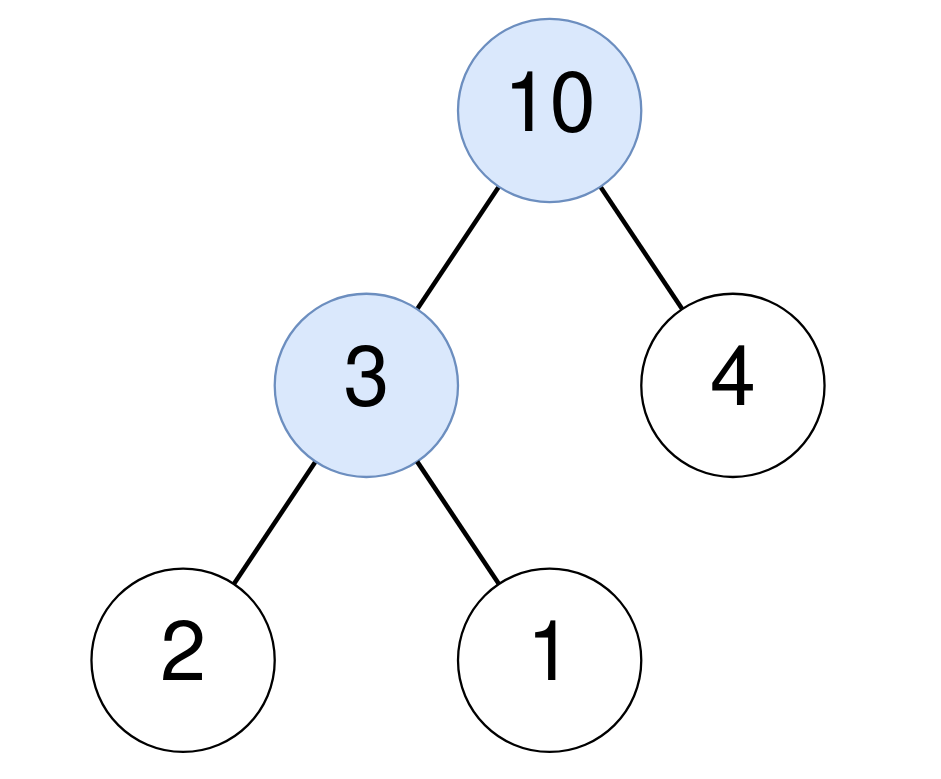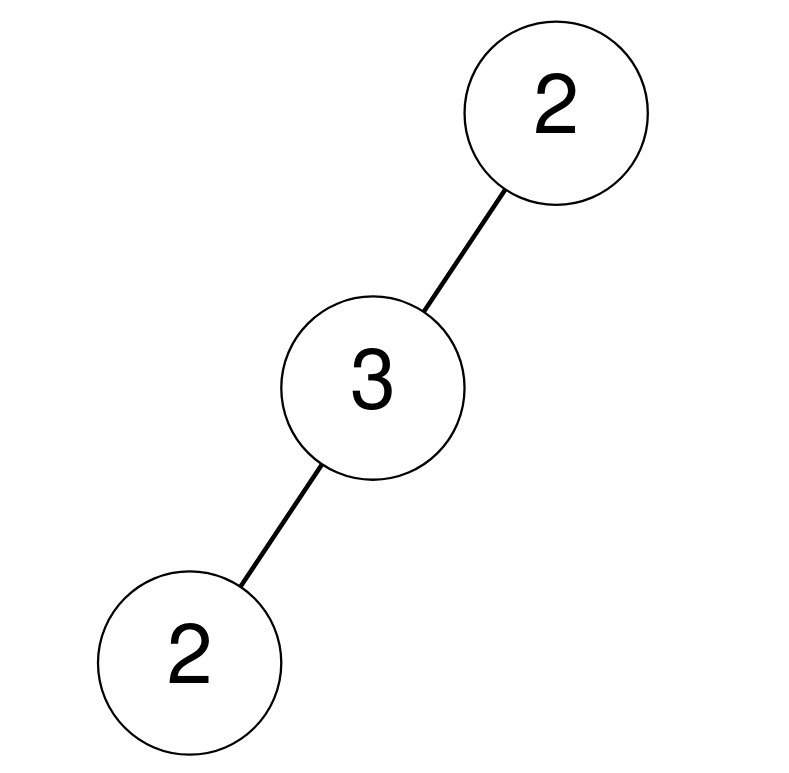二叉树
树
深度优先搜索
题目描述
给定一颗二叉树的根节点 root ,返回满足条件:节点的值等于该节点所有子节点的值之和 的节点的数量。
一个节点 x 的 子节点 是指从节点 x 出发,到所有叶子节点路径上的节点。没有子节点的节点的子节点和视为 0 。
示例 1:
输入: root = [10,3,4,2,1]
输出: 2
解释:
对于值为10的节点: 其子节点之和为: 3+4+2+1 = 10。
对于值为3的节点:其子节点之和为: 2+1 = 3。
示例 2:
输入: root = [2,3,null,2,null]
输出: 0
解释:
没有节点满足其值等于子节点之和。
示例 3:
输入: root = [0]
输出: 1
解释:
对于值为0的节点:因为它没有子节点,所以自己点之和为0。
提示:
树中节点的数量范围: [1, 105 ]
0 <= Node.val <= 105
解法
方法一:递归
我们设计一个函数 \(dfs(root)\) ,该函数返回以 \(root\) 为根节点的子树的所有节点值之和。函数 \(dfs(root)\) 的执行过程如下:
如果 \(root\) 为空,返回 \(0\) ;
否则,我们递归地计算 \(root\) 的左子树和右子树的节点值之和,记为 \(l\) 和 \(r\) ;如果 \(l + r = root.val\) ,说明以 \(root\) 为根节点的子树满足条件,我们将答案加 \(1\) ;最后,返回 \(root.val + l + r\) 。
然后我们调用函数 \(dfs(root)\) ,返回答案即可。
时间复杂度 \(O(n)\) ,空间复杂度 \(O(n)\) 。其中 \(n\) 是二叉树的节点数。
Python3 Java C++ Go
1
2
3
4
5
6
7
8
9
10
11
12
13
14
15
16
17
18
19
20 # Definition for a binary tree node.
# class TreeNode:
# def __init__(self, val=0, left=None, right=None):
# self.val = val
# self.left = left
# self.right = right
class Solution :
def equalToDescendants ( self , root : Optional [ TreeNode ]) -> int :
def dfs ( root ):
if root is None :
return 0
l , r = dfs ( root . left ), dfs ( root . right )
if l + r == root . val :
nonlocal ans
ans += 1
return root . val + l + r
ans = 0
dfs ( root )
return ans
1
2
3
4
5
6
7
8
9
10
11
12
13
14
15
16
17
18
19
20
21
22
23
24
25
26
27
28
29
30
31
32
33
34
35 /**
* Definition for a binary tree node.
* public class TreeNode {
* int val;
* TreeNode left;
* TreeNode right;
* TreeNode() {}
* TreeNode(int val) { this.val = val; }
* TreeNode(int val, TreeNode left, TreeNode right) {
* this.val = val;
* this.left = left;
* this.right = right;
* }
* }
*/
class Solution {
private int ans ;
public int equalToDescendants ( TreeNode root ) {
dfs ( root );
return ans ;
}
private int dfs ( TreeNode root ) {
if ( root == null ) {
return 0 ;
}
int l = dfs ( root . left );
int r = dfs ( root . right );
if ( l + r == root . val ) {
++ ans ;
}
return root . val + l + r ;
}
}
1
2
3
4
5
6
7
8
9
10
11
12
13
14
15
16
17
18
19
20
21
22
23
24
25
26
27
28 /**
* Definition for a binary tree node.
* struct TreeNode {
* int val;
* TreeNode *left;
* TreeNode *right;
* TreeNode() : val(0), left(nullptr), right(nullptr) {}
* TreeNode(int x) : val(x), left(nullptr), right(nullptr) {}
* TreeNode(int x, TreeNode *left, TreeNode *right) : val(x), left(left), right(right) {}
* };
*/
class Solution {
public :
int equalToDescendants ( TreeNode * root ) {
int ans = 0 ;
function < long long ( TreeNode * ) > dfs = [ & ]( TreeNode * root ) -> long long {
if ( ! root ) {
return 0 ;
}
auto l = dfs ( root -> left );
auto r = dfs ( root -> right );
ans += l + r == root -> val ;
return root -> val + l + r ;
};
dfs ( root );
return ans ;
}
};
1
2
3
4
5
6
7
8
9
10
11
12
13
14
15
16
17
18
19
20
21
22
23 /**
* Definition for a binary tree node.
* type TreeNode struct {
* Val int
* Left *TreeNode
* Right *TreeNode
* }
*/
func equalToDescendants ( root * TreeNode ) ( ans int ) {
var dfs func ( * TreeNode ) int
dfs = func ( root * TreeNode ) int {
if root == nil {
return 0
}
l , r := dfs ( root . Left ), dfs ( root . Right )
if l + r == root . Val {
ans ++
}
return root . Val + l + r
}
dfs ( root )
return
}
GitHub



